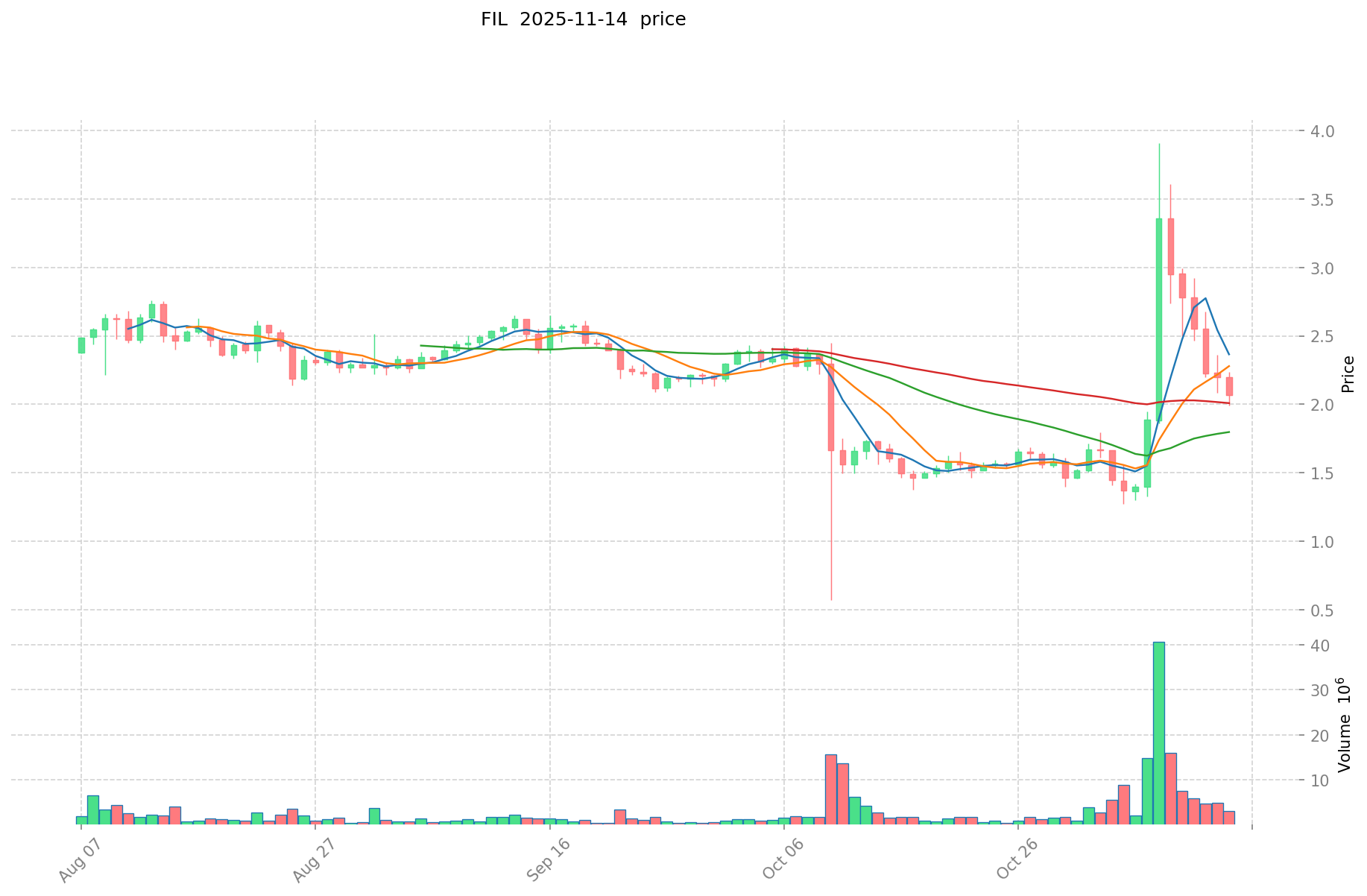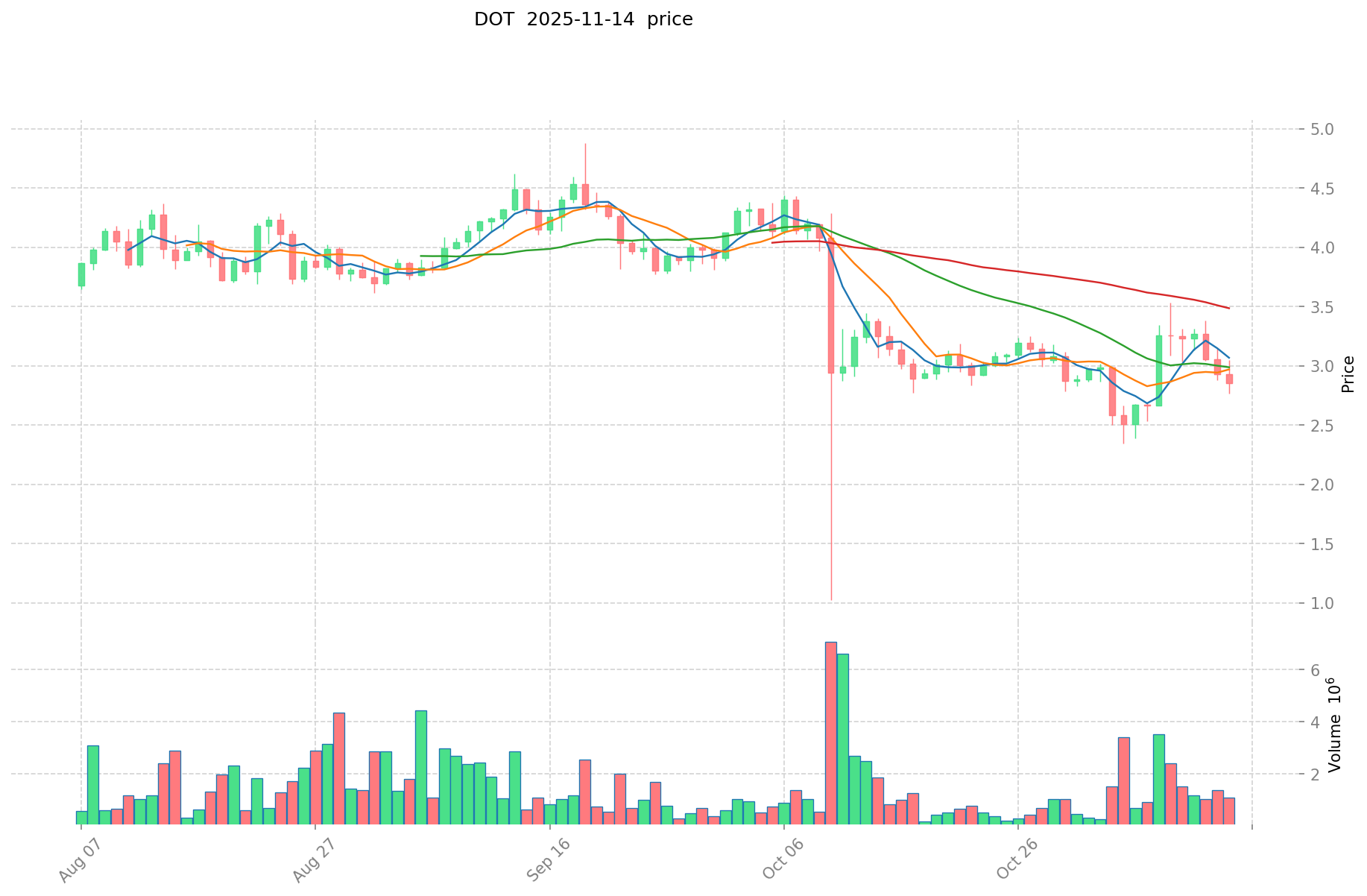FIL vs DOT: Comparing Two Leading Blockchain Infrastructure Tokens
Introduction: FIL vs DOT Investment Comparison
In the cryptocurrency market, the comparison between Filecoin vs Polkadot has always been an unavoidable topic for investors. The two not only have significant differences in market cap ranking, application scenarios, and price performance, but also represent different positions in crypto assets.
Filecoin (FIL): Since its launch in 2020, it has gained market recognition for its decentralized storage network.
Polkadot (DOT): Introduced in 2020, it has been hailed as the "Internet of Blockchains," and is one of the cryptocurrencies with high global trading volume and market capitalization.
This article will provide a comprehensive analysis of the investment value comparison between FIL vs DOT, focusing on historical price trends, supply mechanisms, institutional adoption, technological ecosystems, and future predictions, attempting to answer the question investors are most concerned about:
"Which is the better buy right now?"
I. Price History Comparison and Current Market Status
FIL and DOT Historical Price Trends
- 2021: FIL reached its all-time high of $236.84 on April 1, 2021.
- 2021: DOT hit its all-time high of $54.98 on November 4, 2021.
- Comparative analysis: In the current market cycle, FIL has dropped from its high of $236.84 to a low of $0.848008, while DOT has fallen from $54.98 to a low of $2.13.
Current Market Situation (2025-11-15)
- FIL current price: $1.981
- DOT current price: $2.855
- 24-hour trading volume: FIL $7,462,090.64 vs DOT $2,920,216.62
- Market Sentiment Index (Fear & Greed Index): 16 (Extreme Fear)
Click to view real-time prices:
- View FIL current price Market Price
- View DOT current price Market Price
<>
<二、技术分析与发展对比
{FIL(Coin A)} 技术亮点
{DOT(Coin B)} 技术特性
技术发展路线对比


II. Key Factors Affecting the Investment Value of FIL vs DOT
Supply Mechanisms Comparison (Tokenomics)
- Filecoin (FIL): Maximum supply capped at 2 billion tokens with a deflationary model where tokens are burned through storage provider activities
- Polkadot (DOT): Inflationary model with no maximum supply cap, using inflation to fund network security through staking rewards
- 📌 Historical pattern: Filecoin's deflationary mechanism tends to create potential upward price pressure during periods of network growth, while Polkadot's inflation requires continuous adoption to counterbalance the increasing supply.
Institutional Adoption and Market Applications
- Institutional holdings: Polkadot appears more widely held by institutional investors and venture capital firms, with early backing from prominent crypto investment groups
- Enterprise adoption: Filecoin has gained traction in enterprise data storage solutions, while Polkadot is seeing adoption for cross-chain applications and interoperability solutions
- Regulatory stance: Both projects generally face similar regulatory scrutiny, though Filecoin's utility as a decentralized storage solution may provide clearer regulatory positioning in some jurisdictions
Technical Development and Ecosystem Building
- Filecoin technical upgrades: Network bandwidth improvements and integration with Ethereum Virtual Machine (EVM) compatibility expanding use cases beyond storage
- Polkadot technical development: Ongoing parachain auctions and cross-chain messaging protocols enabling greater interoperability across blockchains
- Ecosystem comparison: Polkadot has developed a more diverse ecosystem spanning DeFi, NFTs, and cross-chain applications, while Filecoin remains more focused on its core storage functionality with emerging compute capabilities
Macroeconomic Factors and Market Cycles
- Performance in inflationary environments: Filecoin's deflationary model potentially offers better theoretical protection against inflation
- Macroeconomic monetary policy: Both assets tend to correlate with overall crypto market movements in response to interest rate changes
- Geopolitical factors: Filecoin's decentralized storage utility may provide additional value during periods of data sovereignty concerns
III. 2025-2030 Price Prediction: FIL vs DOT
Short-term Prediction (2025)
- FIL: Conservative $1.94-$2.00 | Optimistic $2.00-$2.30
- DOT: Conservative $1.87-$2.87 | Optimistic $2.87-$3.36
Mid-term Prediction (2027)
- FIL may enter a growth phase, with expected price range of $1.67-$2.62
- DOT may enter a bullish market, with expected price range of $3.30-$3.98
- Key drivers: Institutional capital inflow, ETF, ecosystem development
Long-term Prediction (2030)
- FIL: Base scenario $3.57-$3.68 | Optimistic scenario $3.68-$5.03
- DOT: Base scenario $5.38-$5.86 | Optimistic scenario $5.86-$6.31
Disclaimer
FIL:
| 年份 | 预测最高价 | 预测平均价格 | 预测最低价 | 涨跌幅 |
|---|---|---|---|---|
| 2025 | 2.30575 | 2.005 | 1.94485 | 1 |
| 2026 | 2.24159 | 2.155375 | 1.7243 | 8 |
| 2027 | 2.616194175 | 2.1984825 | 1.6708467 | 10 |
| 2028 | 3.586934122875 | 2.4073383375 | 2.094384353625 | 21 |
| 2029 | 4.13604799765875 | 2.9971362301875 | 2.607508520263125 | 51 |
| 2030 | 5.028894880631606 | 3.566592113923125 | 3.281264744809275 | 80 |
DOT:
| 年份 | 预测最高价 | 预测平均价格 | 预测最低价 | 涨跌幅 |
|---|---|---|---|---|
| 2025 | 3.36141 | 2.873 | 1.86745 | 0 |
| 2026 | 3.9900224 | 3.117205 | 2.46259195 | 9 |
| 2027 | 3.980047344 | 3.5536137 | 3.304860741 | 24 |
| 2028 | 5.12288950992 | 3.766830522 | 3.3901474698 | 31 |
| 2029 | 6.3117012226632 | 4.44486001596 | 2.4002244086184 | 55 |
| 2030 | 5.862325875049644 | 5.3782806193116 | 4.732886944994208 | 88 |
IV. Investment Strategy Comparison: FIL vs DOT
Long-term vs Short-term Investment Strategies
- FIL: Suitable for investors focused on decentralized storage solutions and data sovereignty
- DOT: Suitable for investors interested in interoperability and cross-chain ecosystem development
Risk Management and Asset Allocation
- Conservative investors: FIL: 30% vs DOT: 70%
- Aggressive investors: FIL: 50% vs DOT: 50%
- Hedging tools: Stablecoin allocation, options, cross-currency portfolios
V. Potential Risk Comparison
Market Risks
- FIL: Highly dependent on adoption of decentralized storage solutions
- DOT: Susceptible to competition from other interoperability-focused blockchains
Technical Risks
- FIL: Scalability, network stability
- DOT: Parachain auction dynamics, security of cross-chain communications
Regulatory Risks
- Global regulatory policies may impact FIL and DOT differently, with FIL potentially facing less scrutiny due to its utility-focused nature
VI. Conclusion: Which Is the Better Buy?
📌 Investment Value Summary:
- FIL advantages: Deflationary tokenomics, growing enterprise adoption for decentralized storage
- DOT advantages: Robust ecosystem development, strong institutional backing, interoperability focus
✅ Investment Recommendations:
- New investors: Consider a balanced approach with a slight preference for DOT due to its wider ecosystem
- Experienced investors: Explore opportunities in both assets, with allocation based on risk tolerance and belief in respective technologies
- Institutional investors: Consider both assets for diversification, with DOT potentially offering more immediate ecosystem exposure
⚠️ Risk Warning: The cryptocurrency market is highly volatile. This article does not constitute investment advice. None
VII. FAQ
Q1: What are the main differences between Filecoin (FIL) and Polkadot (DOT)? A: Filecoin focuses on decentralized storage solutions, while Polkadot emphasizes blockchain interoperability. FIL has a deflationary tokenomics model with a maximum supply cap, whereas DOT has an inflationary model without a supply cap. Polkadot has developed a more diverse ecosystem spanning DeFi, NFTs, and cross-chain applications, while Filecoin remains more focused on its core storage functionality.
Q2: Which cryptocurrency has performed better historically, FIL or DOT? A: Both cryptocurrencies have experienced significant price fluctuations. FIL reached its all-time high of $236.84 on April 1, 2021, while DOT hit its all-time high of $54.98 on November 4, 2021. As of November 15, 2025, FIL is priced at $1.981, and DOT at $2.855, representing substantial declines from their respective peaks.
Q3: How do the long-term price predictions for FIL and DOT compare? A: For 2030, FIL's base scenario price range is predicted to be $3.57-$3.68, with an optimistic scenario of $3.68-$5.03. DOT's base scenario for 2030 is $5.38-$5.86, with an optimistic scenario of $5.86-$6.31. These predictions suggest potentially higher long-term price appreciation for DOT compared to FIL.
Q4: What are the key factors affecting the investment value of FIL and DOT? A: Key factors include supply mechanisms (tokenomics), institutional adoption, market applications, technical development, ecosystem building, and macroeconomic factors. Filecoin's deflationary model and enterprise storage adoption are notable, while Polkadot's diverse ecosystem and interoperability focus are significant strengths.
Q5: How should investors approach allocating between FIL and DOT? A: Conservative investors might consider allocating 30% to FIL and 70% to DOT, while aggressive investors could opt for a 50-50 split. New investors may prefer a balanced approach with a slight preference for DOT due to its wider ecosystem, while experienced investors could explore opportunities in both assets based on their risk tolerance and belief in the respective technologies.
Q6: What are the main risks associated with investing in FIL and DOT? A: Both cryptocurrencies face market risks, technical risks, and regulatory risks. FIL's adoption is highly dependent on decentralized storage solutions, while DOT is susceptible to competition from other interoperability-focused blockchains. Technical risks include scalability and network stability for FIL, and parachain auction dynamics and cross-chain communication security for DOT.
Share
Content